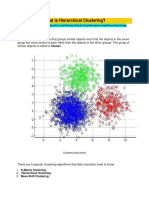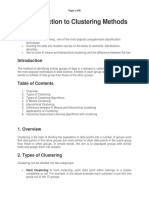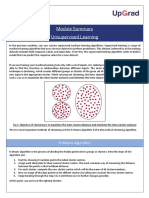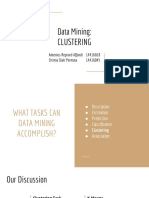0% found this document useful (0 votes)
14 views21 pagesChapter 4 - Clustering
Chapter 4 discusses clustering as an unsupervised machine learning technique for grouping similar data objects, emphasizing methods like K-Means, Hierarchical Clustering, DBSCAN, and K-Nearest Neighbor. It highlights the advantages and disadvantages of each technique, including the assumptions of K-Means and the need for alternatives when those assumptions are violated. The chapter also covers clustering validation methods to assess the quality of clustering results.
Uploaded by
Rana Ben FrajCopyright
© © All Rights Reserved
We take content rights seriously. If you suspect this is your content, claim it here.
Available Formats
Download as PDF, TXT or read online on Scribd
0% found this document useful (0 votes)
14 views21 pagesChapter 4 - Clustering
Chapter 4 discusses clustering as an unsupervised machine learning technique for grouping similar data objects, emphasizing methods like K-Means, Hierarchical Clustering, DBSCAN, and K-Nearest Neighbor. It highlights the advantages and disadvantages of each technique, including the assumptions of K-Means and the need for alternatives when those assumptions are violated. The chapter also covers clustering validation methods to assess the quality of clustering results.
Uploaded by
Rana Ben FrajCopyright
© © All Rights Reserved
We take content rights seriously. If you suspect this is your content, claim it here.
Available Formats
Download as PDF, TXT or read online on Scribd
/ 21

















































































